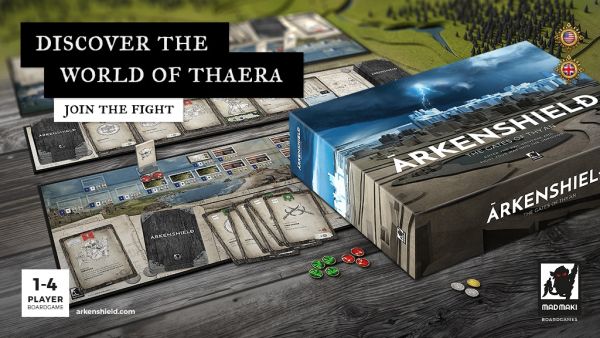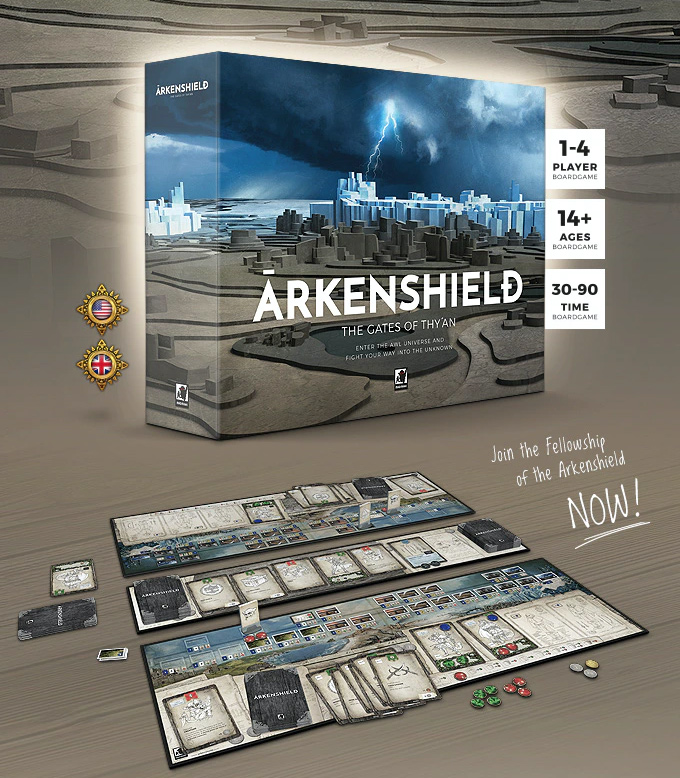Preview: Gather Your Party and Venture Forth in Deck-Building Adventure Arkenshield: The Gates of Thy’an

You must make your way across a dangerous land to reach the gates of the mighty Citadel and conquer it!
Now on Kickstarter, Arkenshield: The Gates of Thy'an is a deck-builder that has players putting a party together and gathering equipment, while picking their path towards their final goal.
Gameplay
Each player takes a player board. This shows the two paths that run from the start point on the left to the citadel on the right. Each player places movement tokens, face-down, on each space on the two paths, and places their player token on the far left of their boards. The inn token is also placed on a randomized space early on one of the two paths. Each player starts the game with a starting companion and a starting deck of ten cards. The main deck is shuffled, and five cards are drawn and placed face-up: these are the cards for sale. There is also a merchant token, which is placed on the path in a similar manner to the inn token. When you reach it, you may use it to get rid of cards you don't want from your deck or sell creature cards you've captured for victory points. Once visited, the merchant token will be placed further along the path, to be visited a second time.
There are four resources in the game: influence, power, experience, and victory points. At the start of your turn you take any resources given to you by your individual companions, and then any given to you by your party bonus. This bonus varies and is based on how many of your companions are of the same type and how many are different. Next, you take any bonuses for the space you are currently on. Then you shuffle your entire deck and draw six cards which you play one at a time. Most cards will gain you resources to spend on this turn, while others may have special abilities, such as doubling the effect of another card played or preventing another player from moving on the path on her next turn.
On your turn, you may choose to flip over a movement tile that is adjacent to your token’s current location. Once a movement tile is flipped over, this locks you in to moving in that direction. Of the two paths on the board, one has fewer spaces than the other, and will get you to the citadel faster, but players earn victory points for each movement tile they defeat. Once you start down one path, you cannot switch to the other until you reach specific crossing locations.
You also need to have a certain amount of experience points in order to move forward on the path. At the start, you only require one, which is automatically given to you by your starting companion, but later you will need two, three, and all the way up to five or six (depending on the path you take) to progress further. The main way to earn extra experience is to buy more companions. However, you can also earn them from defeating a particular enemy and through an event. Also, if you reach the space with the inn token, you may spend six influence to acquire a second companion early in the game, and therefore have two experience early on.
Each movement tile, once flipped, shows how much influence and how much power you must spend to discard it and move forward onto that space. You earn victory points equal to the amount of resources you spent on the movement tile.
On your turn you may also exchange three resources (influence, power, or a combination) for one victory point. You may take this action several times if you have enough resources to do so.
Finally, on your turn you may purchase cards from the cards on sale. Each card lists how much influence it costs to buy it, how many victory points it will be worth at the end of the game, and what resources it is worth when played. Some cards also have special abilities that you can use when the are played. Instead of equipment, some cards on display will be enemies that you can defeat with the power resource, and which earn you victory points, or creatures you can capture.
After a player has finished purchasing cards, new cards are drawn immediately to replace any that were taken. In the deck there are event and emotion cards that come into play when drawn. Emotion cards affect players who have specific types of companions and will have a positive or negative effect. Events typically affect players more generally. Both card types are typically only in effect until each player has taken a turn, and are then discarded.
The first player to reach the citadel earns bonus victory points (but is not neccesarily the winner), and the game ends. The game also ends in the unlikely situation that a player runs out of cards in their deck or loses all their victory points. After the game ends, players count up all their victory points and the player with the most wins the game.
There is also a solo mode in which you play against one of several commanders and lay out expedition tokens for them rather than giving them their own board. Each commander has special abilities or different strengths and weaknesses. Every turn you will reveal one of commander’s expedition tokens which will earn them victory points, may cost you resources or may present you with an enemy to defeat. You are still competing for more victory points than your opponent by the end of the game.

Review
Arkenshield is an intriguing deck-builder that brings some clever twists to the genre. The fact that you shuffle your deck at the start of every turn ensures that you never know exactly what cards you’re going to pull, so you need to think very carefully before putting any card in there and consider the ways different ones will combo off each other depending on what you may happen to draw.
Plotting your path along the board also offers some interesting choices. Whether you want to push ahead for the end goal or hold back and accumulate more points can be a tough choice. You’re going to often be basing the choice off of what your opponents are doing and how far in the lead you think you are. Card abilities also add an additional layer of player interaction.
The events and emotions are a fun way to keep things unpredictable, and we liked the idea of the companions in your party having reactions and emotions of their own that can affect you in your quest.
It can take a little while to teach Arkenshield, as there are several things you need to cover from the cards and resources, to the way the paths work. However, once you start playing, the core gameplay is fairly intuitive, and the cards are good at presenting clearly their abilities and effects.
Also, while the companions are not necessarily tied with victory, they are tied with reaching the end of the game, as they are your main source of experience points which you need to progress along the paths. Consequently, we would have liked if they had appeared a little more frequently in the deck. This would also allow you to play around more with the various combination bonuses the companions give you, which was an interesting mechanic in itself. The designers have informed us that the number of companions will be increased however, and new artwork and abilities hopefully to be unlocked through stretch goals. So hopefully this mechanic will flow a little better in the final version.
Thematically, the game works well. We liked the sense of gathering a party and equipment, and choosing a path across the land to reach your goal, while encountering enemies to fight. It all knits together nicely. The components were also nice quality, and while the prototype did not feature all the final artwork, we quite liked what was there and its general graphic design choices.
Arkenshield feels like you are playing through an adventure. There’s a fun sense of escalation and building up as you progress through it. The game is ambitious, bringing you into a rich world — and despite a bit of a learning curve, we enjoyed our time with it. Check it out on Kickstarter and judge for yourself if it’s the adventure for you.
Pros: Blend of deck-building and a path system, thematic, good art style and component quality
Cons: Takes a little while to learn, game length can vary based on when cards are drawn from the deck
Disclosure: this preview is based on our evaluation of an unpublished prototype of the game, which is subject to change prior to publication. While a modest payment was received to expedite the review process, our thoughts and opinions expressed here are honest and accurate.




